Tutorjohn
On this page, you find all documents, package deals, and flashcards offered by seller tutorjohn.
- 26
- 0
- 0
Community
- Followers
- Following
26 items
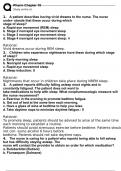
Pharm Chapter 18
1. A patient describes having vivid dreams to the nurse. The nurse under- stands that these occur during which stage of sleep? a. Rapid eye movement (REM) sleep b. Stage 2 nonrapid eye movement sleep c. Stage 3 nonrapid eye movement sleep d. Stage 4 nonrapid eye movement sleep: A Rational: Vivid dreams occur during REM sleep. 2. Children who experience nightmares have these during which stage of sleep? a. Early morning sleep b. Nonrapid eye movement sleep c. Rapid eye movement sleep ...
- Exam (elaborations)
- • 10 pages •
1. A patient describes having vivid dreams to the nurse. The nurse under- stands that these occur during which stage of sleep? a. Rapid eye movement (REM) sleep b. Stage 2 nonrapid eye movement sleep c. Stage 3 nonrapid eye movement sleep d. Stage 4 nonrapid eye movement sleep: A Rational: Vivid dreams occur during REM sleep. 2. Children who experience nightmares have these during which stage of sleep? a. Early morning sleep b. Nonrapid eye movement sleep c. Rapid eye movement sleep ...
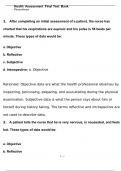
Health Assessment Final Test Bank Questions
1. After completing an initial assessment of a patient, the nurse has charted that his respirations are eupneic and his pulse is 58 beats per minute. These types of data would be: a. Objective b. Reflective c. Subjective d. Introspective: a. Objective Rationale: Objective data are what the health professional observes by inspecting, percussing, palpating, and auscultating during the physical examination. Subjective data is what the person says about him or herself during history taking. T...
- Exam (elaborations)
- • 250 pages •
1. After completing an initial assessment of a patient, the nurse has charted that his respirations are eupneic and his pulse is 58 beats per minute. These types of data would be: a. Objective b. Reflective c. Subjective d. Introspective: a. Objective Rationale: Objective data are what the health professional observes by inspecting, percussing, palpating, and auscultating during the physical examination. Subjective data is what the person says about him or herself during history taking. T...
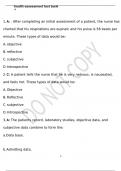
health assessment test bank 1
1. A: . After completing an initial assessment of a patient, the nurse has charted that his respirations are eupneic and his pulse is 58 beats per minute. These types of data would be: A. objective B. reflective C. subjective D. Introspective 2. C: A patient tells the nurse that he is very nervous, is nauseated, and feels hot. These types of data would be: A. Objective B. Reflective C. subjective D. Introspective
- Exam (elaborations)
- • 44 pages •
1. A: . After completing an initial assessment of a patient, the nurse has charted that his respirations are eupneic and his pulse is 58 beats per minute. These types of data would be: A. objective B. reflective C. subjective D. Introspective 2. C: A patient tells the nurse that he is very nervous, is nauseated, and feels hot. These types of data would be: A. Objective B. Reflective C. subjective D. Introspective
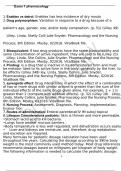
1. Enablex vs detrol: Eneblex has less incidence of dry moutn 2. Drug polymorphism: Variation in response to a drug because of a patient's age, gender, size, and/or body composition. (p. 51) (Lilley 49) Lilley, Linda, Shelly Colli Julie Snyder. Pharmac
1. Enablex vs detrol: Eneblex has less incidence of dry moutn 2. Drug polymorphism: Variation in response to a drug because of a patient's age, gender, size, and/or body composition. (p. 51) (Lilley 49) Lilley, Linda, Shelly Colli Julie Snyder. Pharmacology and the Nursing Process, 8th Edition. Mosby, 022016. VitalBook file. 3. Bioequivalent: If two drug products have the same bioavailability and same concentration of active ingredient, they are said to be (Lilley 21) Lilley, Linda, She Colli...
- Exam (elaborations)
- • 13 pages •
1. Enablex vs detrol: Eneblex has less incidence of dry moutn 2. Drug polymorphism: Variation in response to a drug because of a patient's age, gender, size, and/or body composition. (p. 51) (Lilley 49) Lilley, Linda, Shelly Colli Julie Snyder. Pharmacology and the Nursing Process, 8th Edition. Mosby, 022016. VitalBook file. 3. Bioequivalent: If two drug products have the same bioavailability and same concentration of active ingredient, they are said to be (Lilley 21) Lilley, Linda, She Colli...
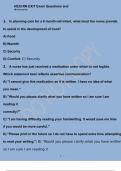
HESI RN Exit Exam
HESI RN Exit Exam
- Exam (elaborations)
- • 87 pages •
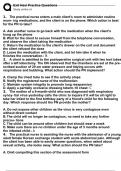
Exit Hesi Practice Questions
Exit Hesi Practice Questions
- Exam (elaborations)
- • 35 pages •
Exit Hesi Practice Questions
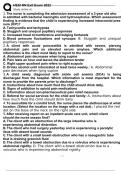
HESI RN Exit Exam 2022
HESI RN Exit Exam 2022
- Exam (elaborations)
- • 61 pages •
HESI RN Exit Exam 2022
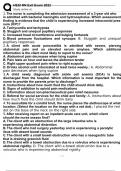
HESI RN Exit Exam 2022
HESI RN Exit Exam 2022
- Exam (elaborations)
- • 61 pages •
HESI RN Exit Exam 2022
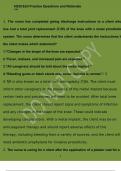
HESI Exit Practice Questions and Rationale (2)
HESI Exit Practice Questions and Rationale (2)
- Exam (elaborations)
- • 160 pages •
HESI Exit Practice Questions and Rationale (2)
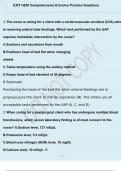
EXIT HESI Comprehensive B Evolve Practice Questions
EXIT HESI Comprehensive B Evolve Practice Questions
- Exam (elaborations)
- • 97 pages •
EXIT HESI Comprehensive B Evolve Practice Questions
